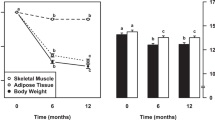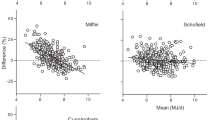ABSTRACT
Body mass in humans and animals is strongly associated with the rate of heat production as defined by resting energy expenditure (REE). Beginning with the ancient Greeks up to the present time, philosophers and scientists have endeavored to understand the nature and sources of bodily heat. Today we recognize that body mass consists of organs and tissues, each of which produces a specified amount of heat at rest. An individual organ’s REE can now be estimated in vivo as the product of its assumed mass-specific metabolic rate and its imaging-derived mass; whole-body REE reflects the sum of organ and tissue metabolic rates. The sizes of organs and total body mass in adults are governed by two main factors, a person’s stature or height, and their level of adiposity. With greater body size, as represented by adult height independent of adiposity, organs remain stable or increase in mass according to distinct “scaling” patterns. Similarly, with greater relative adiposity organs adaptively accommodate to the increase in imposed mechanical and metabolic loading conditions. Through a detailed analysis of these stature and adiposity effects, we show how classical statistical REE prediction models can be mechanistically understood at the anatomic body composition level.
This is a preview of subscription content, access via your institution
Access options
Subscribe to this journal
Receive 12 print issues and online access
$259.00 per year
only $21.58 per issue
Buy this article
- Purchase on Springer Link
- Instant access to full article PDF
Prices may be subject to local taxes which are calculated during checkout




Similar content being viewed by others
References
Kleiber M. Body size and metabolism. Hilgardia. 1932;6:315–53.
Food and Agriculture Organization (FAO). Calorie requirements: report of the second committee on calorie requirements (FAO nutritional studies no. 15). Rome: FAO of the United Nations; 1957.
Harris JA, Benedict FG. A biometric study of human basal metabolism. Proc Natl Acad Sci USA. 1918;4:370–3.
Heymsfield SB, Peterson CM, Thomas DM, Heo M, Schuna JM Jr. Why are there race/ethnic differences in adult body mass index-adiposity relationships? A quantitative critical review. Obes Rev. 2016;17:262–75.
Zembron-Lacny A, Dziubek W, Rogowski L, Skorupka E, Dabrowska G. Sarcopenia: monitoring, molecular mechanisms, and physical intervention. Physiol Res. 2014;63:683–91.
International Commission on Radiological Protection. Task group on reference man. Report of the task group on reference man: a report. Oxford, New York: Pergamon Press; 1975. xix, 480pp.
Field J, Belding HS, Martin AW. An analysis of the relation between basal metabolism and summated tissue respiration in the rat I. The post-pubertal albino rat. J Cell Compar Physl. 1939;14:143–57.
Gallagher D, Belmonte D, Deurenberg P, Wang Z, Krasnow N, Pi-Sunyer FX, et al. Organ-tissue mass measurement allows modeling of REE and metabolically active tissue mass. Am J Physiol. 1998;275 Partt 1:E249–58.
Illner K, Brinkmann G, Heller M, Bosy-Westphal A, Muller MJ. Metabolically active components of fat free mass and resting energy expenditure in nonobese adults. Am J Physiol Endocrinol Metab. 2000;278:E308–15.
Elia M. Organ and tissue contribution to metabolic rate. In: Kinney JM, Tucker HN, editors. Energy metabolism: tissue determinants and cellular corollaries. New York: Raven Press; 1992. p. 61–79.
Heymsfield SB, Peterson CM, Bourgeois B, Thomas DM, Gallagher D, Strauss B, Muller MJ, Bosy-Westphal A. Human Energy Expenditure: advances in organ-tissue prediction models. Obes Rev. 2018;19:1177–1188.
Heymsfield SB, Childers D, Beetsch J, Allison DB, Pietrobelli A. Body size and human energy requirements: reduced mass-specific resting energy expenditure in tall adults. J Appl Physiol (1985). 2007;103:1543–50.
Heymsfield SB, Chirachariyavej T, Rhyu IJ, Roongpisuthipong C, Heo M, Pietrobelli A. Differences between brain mass and body weight scaling to height: potential mechanism of reduced mass-specific resting energy expenditure of taller adults. J Appl Physiol (1985). 2009;106:40–8.
Heymsfield SB, Gallagher D, Mayer L, Beetsch J, Pietrobelli A. Scaling of human body composition to stature: new insights into body mass index. Am J Clin Nutr. 2007;86:82–91.
Heymsfield SB, Muller MJ, Bosy-Westphal A, Thomas D, Shen W. Human brain mass: similar body composition associations as observed across mammals. Am J Hum Biol. 2012;24:479–85.
Heymsfield SB, Peterson CM, Thomas DM, Heo M, Schuna JM Jr, Hong S, et al. Scaling of adult body weight to height across sex and race/ethnic groups: relevance to BMI. Am J Clin Nutr. 2014;100:1455–61.
Heymsfield SB. Energy expenditure—body size associations: molecular coordination. Eur J Clin Nutr. 2018;72:1314–1319.
Lui JC, Baron J. Mechanisms limiting body growth in mammals. Endocr Rev. 2011;32:422–40.
Weibel ER. Symmorphosis: on form and function in shaping life. Cambridge, MA: Harvard University Press; 2000.
Ford LE. Heart size. Circ Res. 1976;39:297–303.
Heymsfield SB, Gonzalez MC, Thomas D, Murray K, Jia G, Cattrysse E. et al. Adult human ocular volume: scaling to body size and composition. Anat Physiol. 2016;6:239 https://doi.org/10.4172/2161-0940.1000239
Acknowledgements
The author acknowledges Melanie Peterson for her support in preparing this review.
Funding
This work was partially supported by two National Institutes of Health NORC Center Grants P30DK072476, Pennington/Louisiana; and P30DK040561, Harvard; and R01DK109008, Shape UP! Adults.
Author contributions
SBH, DMT, ABW, and MJM drafted the manuscript and edited the manuscript for intellectual content.
Author information
Authors and Affiliations
Corresponding author
Ethics declarations
Conflict of interest
The author SBH is on the Medical Advisory Boards of Tanita and Medifast Corporations. The other authors declare that they have no conflict of interest.
Electronic supplementary material
Rights and permissions
About this article
Cite this article
Heymsfield, S.B., Thomas, D.M., Bosy-Westphal, A. et al. The anatomy of resting energy expenditure: body composition mechanisms. Eur J Clin Nutr 73, 166–171 (2019). https://doi.org/10.1038/s41430-018-0319-3
Received:
Accepted:
Published:
Issue Date:
DOI: https://doi.org/10.1038/s41430-018-0319-3
This article is cited by
-
From a “Metabolomics fashion” to a sound application of metabolomics in research on human nutrition
European Journal of Clinical Nutrition (2020)



